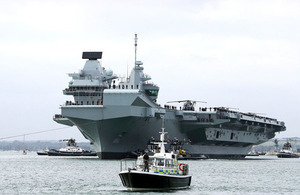Dstl scientists take to the high seas on HMS Queen Elizabeth
As HMS Queen Elizabeth makes her way across the Atlantic deploying for her longest sea trial to date, a pair of scientists from the Defence, Science and Technology Laboratory (Dstl) are on-board as part of an analytic research team.

Image Crown Copyright: Royal Navy aircraft carrier, HMS Queen Elizabeth, departs her home port of Portsmouth, bound for the USA to land fast jets on deck for the very first time.
Dstl has been involved in the development of HMS Queen Elizabeth for the past 20 years, starting with the original study to replace the Invincible light carrier fleet. Dstl helped to define the size and shape of the ship and a specialist team investigated ship-air integration, which supported the design of the flight deck and ski-jump used to launch the F-35B Lightning II fighter jets.
Currently on-board is Dstl operational analyst Tom, who will be joined later in September by Hannah, both of whom will provide vital analysis to the battle group and commanders during the voyage. It will be HMS Queen Elizabeth’s maiden voyage across the Atlantic as she prepares to embark her first F-35B Lightning II fighter jets. She is one of two new aircraft carriers built for the Royal Navy with the second, HMS Prince of Wales, nearing the end of construction in Rosyth.
The aim of the flight trials is to use specially equipped test aircraft and sensors around the ship to work out the operating parameters of the aircraft and the carrier itself in a range of conditions. The carrier has already conducted similar trials for helicopters.
During the exercise, Dstl scientists will focus on operational analysis, gathering data that will be used inform future operational activity.
Tom said:
This is a fantastic opportunity, not only to be part of Dstl’s continued involvement with the carrier, but to join more than 1,000 military personnel on-board. It’s a huge craft and quite daunting – and also the first time I’ve deployed to sea, let alone on the Queen Elizabeth – but I’m very much looking forward to the tasks ahead and hopefully witness the F-35 jets on-board and in action off the flight deck for the first time.
In addition to providing analytic support to the carrier strike group and commanders, analysis will include looking at the way manpower use can be improved, from how efficiently the vessel can be cleaned to the sortie rates the fighter aircraft can carry out.
Tom added:
Analysis at this level has never been done before, so we will be learning on task; helping to adapt and shape the way the ship will run come its first operational deployment in 2021.